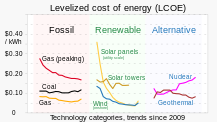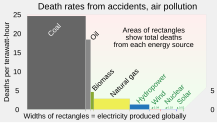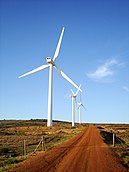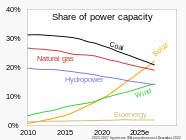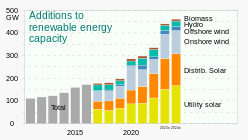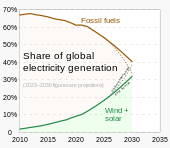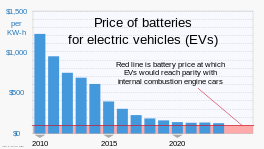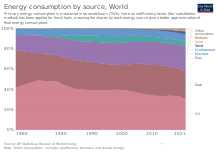Energy transition
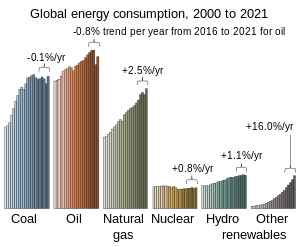
An energy transition (or energy system transformation) is a major structural change to energy supply and consumption in an energy system. Currently, a transition to sustainable energy is underway to limit climate change. Most of the sustainable energy is renewable energy. Therefore, another term for energy transition is renewable energy transition. The current transition aims to reduce greenhouse gas emissions from energy quickly and sustainably, mostly by phasing-down fossil fuels and changing as many processes as possible to operate on low carbon electricity.[2] A previous energy transition perhaps took place during the Industrial Revolution from 1760 onwards, from wood and other biomass to coal, followed by oil and later natural gas.[3][4]
Over three-quarters of the world's energy needs are met by burning fossil fuels, but this usage emits greenhouse gases.[5] Energy production and consumption are responsible for most human-caused greenhouse gas emissions.[6] To meet the goals of the 2015 Paris Agreement on climate change, emissions must be reduced as soon as possible and reach net-zero by mid-century.[7] Since the late 2010s, the renewable energy transition has also been driven by the rapidly falling cost of both solar and wind power.[8] Another benefit of the energy transition is its potential to reduce the health and environmental impacts of the energy industry.[9]
Heating of buildings is being electrified, with heat pumps being the most efficient technology by far.[10] To improve the flexibility of electrical grids, the installation of energy storage and super grids are vital to enable the use of variable, weather-dependent technologies.[11] However fossil-fuel subsidies are slowing the energy transition.[12][13]
Definition
An energy transition is a broad shift in technologies and behaviours that are needed to replace one source of energy with another.[14]: 202–203 A prime example is the change from a pre-industrial system relying on traditional biomass, wind, water and muscle power to an industrial system characterized by pervasive mechanization, steam power and the use of coal.
The IPCC does not define energy transition in the glossary of its Sixth Assessment Report but it does define transition as: "The process of changing from one state or condition to another in a given period of time. Transition can occur in individuals, firms, cities, regions and nations, and can be based on incremental or transformative change."[15]
Development of the term
| Part of a series on |
| Sustainable energy |
|---|
 |
After the 1973 oil crisis, the term energy transition was coined by politicians and media. It was popularised by US President Jimmy Carter in his 1977 Address on the Nation on Energy, calling to "look back into history to understand our energy problem. Twice in the last several hundred years, there has been a transition in the way people use energy ... Because we are now running out of gas and oil, we must prepare quickly for a third change to strict conservation and to the renewed use of coal and to permanent renewable energy sources like solar power."[16] The term was later globalised after the 1979 second oil shock, during the 1981 United Nations Conference on New and Renewable Sources of Energy.[17]
From the 1990s, debates on energy transition have increasingly taken climate change mitigation into account. Parties to the agreement committed "to limit global warming to "well below 2 °C, preferably 1.5 °C compared to pre-industrial levels".[18] This requires a rapid energy transition with a downshift of fossil fuel production to stay within the carbon emissions budget.[19]
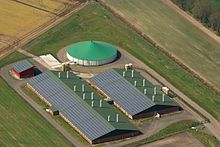
In this context, the term energy transition encompasses a reorientation of energy policy. This could imply a shift from centralized to distributed generation. It also includes attempts to replace overproduction and avoidable energy consumption with energy-saving measures and increased efficiency.[20]
The historical transitions from locally supplied wood, water and wind energies to globally supplied fossil and nuclear fuels has induced growth in end-use demand through the rapid expansion of engineering research, education and standardisation. The mechanisms for the whole-systems changes include new discipline in Transition Engineering amongst all engineering professions, entrepreneurs, researchers and educators.[21]
However it has been argued that the term is a mere slogan and that rather than transitioning, as of 2024, use of all forms of primary energy has increased.[22]
Examples of past energy transitions
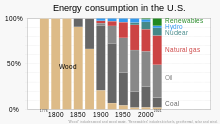
Historic approaches to past energy transitions are shaped by two main discourses. One argues that humankind experienced several energy transitions in its past, while the other suggests the term "energy additions" as better reflecting the changes in global energy supply in the last three centuries.
The chronologically first discourse was most broadly described by Vaclav Smil.[24] It underlines the change in the energy mix of countries and the global economy. By looking at data in percentages of the primary energy source used in a given context, it paints a picture of the world's energy systems as having changed significantly over time, going from biomass to coal, to oil, and now a mix of mostly coal, oil and natural gas. Until the 1950s, the economic mechanism behind energy systems was local rather than global.[25]
The second discourse was most broadly described by Jean-Baptiste Fressoz.[26] It emphasises that the term "energy transition" was first used by politicians, not historians, to describe a goal to achieve in the future – not as a concept to analyse past trends. When looking at the sheer amount of energy being used by humankind, the picture is one of ever-increasing consumption of all the main energy sources available to humankind.[27] For instance, the increased use of coal in the 19th century did not replace wood consumption, indeed more wood was burned. Another example is the deployment of passenger cars in the 20th century. This evolution triggered an increase in both oil consumption (to drive the car) and coal consumption (to make the steel needed for the car). In other words, according to this approach, humankind never performed a single energy transition in its history but performed several energy additions.
Contemporary energy transitions differ in terms of motivation and objectives, drivers and governance. As development progressed, different national systems became more and more integrated becoming the large, international systems seen today. Historical changes of energy systems have been extensively studied.[28] While historical energy changes were generally protracted affairs, unfolding over many decades, this does not necessarily hold true for the present energy transition, which is unfolding under very different policy and technological conditions.[29]
For current energy systems, many lessons can be learned from history.[30][31][obsolete source] [dubious – discuss]The need for large amounts of firewood in early industrial processes in combination with prohibitive costs for overland transportation led to a scarcity of accessible (e.g. affordable) wood, and eighteenth century glass-works "operated like a forest clearing enterprise".[32] When Britain had to resort to coal after largely having run out of wood, the resulting fuel crisis triggered a chain of events that two centuries later culminated in the Industrial Revolution.[33][34] Similarly, increased use of peat and coal were vital elements paving the way for the Dutch Golden Age, roughly spanning the entire 17th century.[35] Another example where resource depletion triggered technological innovation and a shift to new energy sources is 19th century whaling: whale oil eventually became replaced by kerosene and other petroleum-derived products.[36] To speed up the energy transition it is also conceivable that there will be government buyouts or bailouts of coal mining regions.[37]
Drivers for current energy transition
(Levelized cost of energy (LCOE) is a measure of the average net present cost of electricity generation for a generating plant over its lifetime.)
Climate change mitigation and co-benefits
A rapid energy transition to very-low or zero-carbon sources is required to mitigate the effects of climate change.[41]: 66 [42]: 11 Coal, oil and gas combustion account for 89% of CO2 emissions[43]: 20 and still provide 78% of primary energy consumption.[44]: 12
Despite the knowledge about the risks of climate change and the increasing number of climate policies adopted since the 1980s, however, energy transitions have not accelerated towards decarbonization beyond historical trends and remain far off track in achieving climate targets.[45]
The deployment of renewable energy can generate co-benefits of climate change mitigation: positive socio-economic effects on employment, industrial development, health and energy access. Depending on the country and the deployment scenario, replacing coal power plants can more than double the number of jobs per average MW capacity.[46] The energy transition could create many green jobs,[47] for example in Africa.[48][49] The costs for retraining workers for the renewable energy industry was found to be trivial for both coal[50] in the U.S. and oil sands in Canada.[51] The latter of which would only demand 2–6% of federal, provincial, and territorial oil and gas subsidies for a single year to be reallocated to provide oil and gas workers with a new career of approximately equivalent pay.[51][52] In non-electrified rural areas, the deployment of solar mini-grids can significantly improve electricity access.[53]
Employment opportunities by the green transition are associated with the use of renewable energy sources or building activity for infrastructure improvements and renovations.[54][55]
Energy security
Another important driver is energy security and independence, with increasing importance in Europe and Taiwan[56] because of the 2022 Russian invasion of Ukraine.[57] Unlike Europes 2010s dependence on Russian gas, even if China stops supplying solar panels those already installed continue generating electricity.[58] Militaries are using and developing electric vehicles, particularly for their stealthiness,[59] but not tanks.[60] As of 2023 renewable energy in Taiwan is far too small to help in a blockade.[61]
Centralised facilities such as oil refineries[62] and thermal power plants can be put out of action by air attack, whereas although solar can be attacked[63] decentralised power such as solar and wind[64] may be less vulnerable.[65][66] Solar and batteries reduces risky fuel convoys.[67][68] However large hydropower plants are vulnerable.[69] Some say that nuclear power plants are unlikely to be military targets,[70] but others conclude that civil NPPs in war zones can be weaponised and exploited by the hostile forces not only for impeding energy supplies (and thus shattering the public morale of the adversary) but also for blackmailing and coercing the decisionmakers of the attacked state and their international allies with a vision of man-made nuclear disaster.[71]
Economic development
For many developing economies, for example in the mineral-rich countries of Sub-Saharan Africa, the transition to renewable energies is predicted to become a driver of sustainable economic development. The International Energy Agency (IEA) has identified 37 minerals as critical for clean energy technologies and estimates that by 2050 global demand for these will increase by 235 per cent.[72][73][need quotation to verify] Africa has large reserves of many of these so-called "green minerals, such as bauxite, cobalt, copper, chromium, manganese and graphite.[74] The African Union has outlined a policy framework, the Africa Mining Vision, to leverage the continent's mineral reserves in pursuit of sustainable development and socio-economic transformation.[75] Achieving these goals requires mineral-rich African economies to transition from commodity export to manufacture of higher value-added products.[76]
Cost competitiveness of renewable energies
From 2010 to 2019, the competitiveness of wind and solar power substantially increased. Unit costs of solar energy dropped sharply by 85%, wind energy by 55%, and lithium-ion batteries by 85%.[77]: 11 This has made wind and solar power the cheapest form for new installations in many regions. Levelized costs for combined onshore wind or solar with storage for a few hours are already lower than for gas peaking power plants.[78] In 2021, the new electricity generating capacity of renewables exceeded 80% of all installed power.[79]: 3
Key technologies and approaches
The emissions reductions necessary to keep global warming below 2 °C will require a system-wide transformation of the way energy is produced, distributed, stored, and consumed.[80]: 46 For a society to replace one form of energy with another, multiple technologies and behaviours in the energy system must change.[14]: 202–203
Many climate change mitigation pathways envision three main aspects of a low-carbon energy system:
- The use of low-emission energy sources to produce electricity
- Electrification – that is increased use of electricity instead of directly burning fossil fuels
- Accelerated adoption of energy efficiency measures[81]: 7.11.3
Renewable energy
The most important energy sources in the low carbon energy transition are wind power and solar power. They could reduce net emissions by 4 billion tons CO2 equivalent per year each, half of it with lower net lifetime costs than the reference.[77]: 38 Other renewable energy sources include bioenergy, geothermal energy and tidal energy, but they currently have higher net lifetime costs.[77]: 38
By 2022, hydroelectricity is the largest source of renewable electricity in the world, providing 16% of the world's total electricity in 2019.[90] However, because of its heavy dependence on geography and the generally high environmental and social impact of hydroelectric power plants, the growth potential of this technology is limited. Wind and solar power are considered more scalable, but still require vast quantities of land and materials. They have higher potential for growth.[91] These sources have grown nearly exponentially in recent decades thanks to rapidly decreasing costs. In 2019, wind power supplied 5.3% worldwide electricity while solar power supplied 2.6%.[90]
While production from most types of hydropower plants can be actively controlled, production from wind and solar power depends on the weather. Electrical grids must be extended and adjusted to avoid wastage. Dammed hydropower is a dispatchable source, while solar and wind are variable renewable energy sources. These sources require dispatchable backup generation or energy storage to provide continuous and reliable electricity. For this reason, storage technologies also play a key role in the renewable energy transition. As of 2020, the largest scale storage technology is pumped storage hydroelectricity, accounting for the great majority of energy storage capacity installed worldwide. Other important forms of energy storage are electric batteries and power to gas.
The "Electricity Grids and Secure Energy Transitions" report by the IEA emphasizes the necessity of increasing grid investments to over $600 billion annually by 2030, up from $300 billion, to accommodate the integration of renewable energy. By 2040, the grid must expand by more than 80 million kilometers to manage renewable sources, which are projected to account for over 80% of the global power capacity increase over the next two decades. Failure to enhance grid infrastructure timely could lead to an additional 58 gigatonnes of CO2 emissions by 2050, significantly risking a 2°C global temperature rise.[92][93]
Integration of variable renewable energy sources
With the integration of renewable energy, local electricity production is becoming more variable. It has been recommended that "coupling sectors, energy storage, smart grids, demand side management, sustainable biofuels, hydrogen electrolysis and derivatives will ultimately be needed to accommodate large shares of renewables in energy systems".[77]: 28 Fluctuations can be smoothened by combining wind and sun power and by extending electricity grids over large areas. This reduces the dependence on local weather conditions.
With highly variable prices, electricity storage and grid extension become more competitive. Researchers have found that "costs for accommodating the integration of variable renewable energy sources in electricity systems are expected to be modest until 2030".[77]: 39 Furthermore, "it will be more challenging to supply the entire energy system with renewable energy".[77]: 28
Fast fluctuations increase with a high integration of wind and solar energy. They can be addressed by operating reserves. Large-scale batteries can react within seconds and are increasingly used to keep the electricity grid stable.
100% renewable energy
100% renewable energy is the goal of the use renewable resources for all energy. 100% renewable energy for electricity, heating, cooling and transport is motivated by climate change, pollution and other environmental issues, as well as economic and energy security concerns. Shifting the total global primary energy supply to renewable sources requires a transition of the energy system, since most of today's energy is derived from non-renewable fossil fuels.
Research into this topic is fairly new, with few studies published before 2009, but has gained increasing attention in recent years. The majority of studies show that a global transition to 100% renewable energy across all sectors – power, heat, transport and industry – is feasible and economically viable.[94][95][96][97][need quotation to verify] A cross-sectoral, holistic approach is seen as an important feature of 100% renewable energy systems and is based on the assumption "that the best solutions can be found only if one focuses on the synergies between the sectors" of the energy system such as electricity, heat, transport or industry.[98]
The main barriers to the widespread implementation of large-scale renewable energy and low-carbon energy strategies are seen to be primarily social and political rather than technological or economic.[99] The key roadblocks are: climate change denial, the fossil fuels lobby, political inaction, unsustainable energy consumption, outdated energy infrastructure, and financial constraints.[100]Nuclear power

In the 1970s and 1980s, nuclear power gained a large share in some countries. In France and Slovakia more than half of the electrical power is still nuclear. It is a low carbon energy source but comes with risks and increasing costs. Since the late 1990s, deployment has slowed down. Decommissioning increases as many reactors are close to the end of their lifetime or long before because of anti-nuclear sentiments. Germany stopped its last three nuclear power plants by mid April 2023. On the other hand, the China General Nuclear Power Group is aiming for 200 GW by 2035, produced by 150 additional reactors.[102]
Electrification
With the switch to clean energy sources where power is generated via electricity, end uses of energy such as transportation and heating need to be electrified to run on these clean energy sources. Concurrent with this switch is an expansion of the grid to handle larger amounts of generated electricity to supply to these end uses. Two key areas of electrification are electric vehicles and heat pumps.
It is easier to sustainably produce electricity than it is to sustainably produce liquid fuels.[citation needed] Therefore, adoption of electric vehicles is a way to make transport more sustainable.[103] While electric vehicle technology is relatively mature in road transport, electric shipping and aviation are still early in their development, hence sustainable liquid fuels may have a larger role to play in these sectors.[104]: 139
A key sustainable solution to heating is electrification (heat pumps, or the less efficient electric heater). The IEA estimates that heat pumps currently provide only 5% of space and water heating requirements globally, but could provide over 90%.[105] Use of ground source heat pumps not only reduces total annual energy loads associated with heating and cooling, it also flattens the electric demand curve by eliminating the extreme summer peak electric supply requirements.[106] However, heat pumps and resistive heating alone will not be sufficient for the electrification of industrial heat. This because in several processes higher temperatures are required which cannot be achieved with these types of equipment. For example, for the production of ethylene via steam cracking temperatures as high as 900 °C are required. Hence, drastically new processes are required. Nevertheless, power-to-heat is expected to be the first step in the electrification of the chemical industry with an expected large-scale implementation by 2025.[107]
Economic and geopolitical aspects
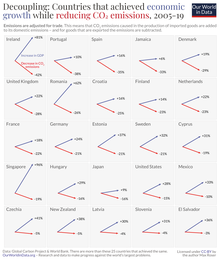
A shift in energy sources has the potential to redefine relations and dependencies between countries, stakeholders and companies. Countries or land owners with resources – fossil or renewable – face massive losses or gains depending on the development of any energy transition. In 2021, energy costs reached 13% of global gross domestic product.[108] Global rivalries have contributed to the driving forces of the economics behind the low carbon energy transition. Technological innovations developed within a country have the potential to become an economic force.[109]
Influences

The energy transition discussion is heavily influenced by contributions from the fossil fuel industries.[111] One way that oil companies are able to continue their work despite growing environmental, social and economic concerns is by lobbying local and national governments.
Historically, the fossil fuel lobby has been highly successful in limiting regulations. From 1988 to 2005, Exxon Mobil, one of the largest oil companies in the world, spent nearly $16 million in anti-climate change lobbying and providing misleading information about climate change to the general public.[112] The fossil fuel industry acquires significant support through the existing banking and investment structure.[113] The concept that the industry should no longer be financially supported has led to the social movement known as divestment. Divestment is defined as the removal of investment capital from stocks, bonds or funds in oil, coal and gas companies for both moral and financial reasons.[114]
Banks, investing firms, governments, universities, institutions and businesses are all being challenged with this new moral argument against their existing investments in the fossil fuel industry and many; such as Rockefeller Brothers Fund, the University of California, New York City and more; have begun making the shift to more sustainable, eco-friendly investments.[115]
In 2024 the International Renewable Energy Agency (IRENA) projected that by 2050, over half of the world's energy will be carried by electricity and over three-quarters of the global energy mix will be from renewables. Although overtaken by both biomass and clean hydrogen, fossil fuels were still projected to supply 12% of energy. The transition is expected to reshape geopolitical power by reducing reliance on long-distance fossil fuel trade and enhancing the importance of regional energy markets.[116]
Social and environmental aspects
Impacts
A renewable energy transition can present negative social impacts for some people who rely on the existing energy economy or who are affected by mining for minerals required for the transition. This has led to calls for a just transition, which the IPCC defines as, "A set of principles, processes and practices that aim to ensure that no people, workers, places, sectors, countries or regions are left behind in the transition from a high-carbon to a low carbon economy."[15]
Use of local energy sources may stabilise and stimulate some local economies,[117] create opportunities for energy trade between communities, states and regions,[118][need quotation to verify] and increase energy security.[119]
Coal mining is economically important in some regions, and a transition to renewables would decrease its viability and could have severe impacts on the communities that rely on this business.[120] Not only do these communities face energy poverty already,[need quotation to verify] but they also face economic collapse when the coal mining businesses move elsewhere or disappear altogether.[121] This broken system perpetuates the poverty and vulnerability that decreases the adaptive capacity of coal mining communities.[121] Potential mitigation could include expanding the program base[clarification needed] for vulnerable communities to assist with new training programs, opportunities for economic development and subsidies to assist with the transition.[122]
Increasing energy prices resulting from an energy transition may negatively impact developing countries including Vietnam and Indonesia.[123]
Increased mining for lithium, cobalt, nickel, copper, and other critical minerals needed for expansion of renewable energy infrastructure has created increased environmental conflict and environmental justice issues for some communities.[124][125]
Labour
A large portion of the global workforce works directly or indirectly for the fossil fuel economy.[126][need quotation to verify] Moreover, many other industries are currently dependent on unsustainable energy sources (such as the steel industry or cement and concrete industry). Transitioning these workforces during the rapid period of economic change requires considerable forethought and planning. The international labor movement has advocated for a just transition that addresses these concerns.[citation needed]
Recently,[127] an energy crisis is upon the nations of Europe as a result of dependence on Russia's natural gas, which was cut off during the Russia-Ukraine war. This goes to show that humanity is still heavily dependent on fossil fuel energy sources and care should be taken to have a smooth transition, less energy-shortage shocks cripple the very efforts to effectively energise the transition.[citation needed]
Risks and barriers
Amongst the key issues to consider in relation to the pace of the global transition to renewables is how well individual electric companies are able to adapt to the changing reality of the power sector. For example, to date, the uptake of renewables by electric utilities has remained slow, hindered by their continued investment in fossil fuel generation capacity.[128]
Incomplete regulations on clean energy uptake and concerns about electricity shortages have been identified as key barriers to the energy transition in coal-dependent, fast developing economies such as Vietnam.[123]
Examples by country
From 2000 to 2012 coal was the source of energy with the total largest growth. The use of oil and natural gas also had considerable growth, followed by hydropower and renewable energy. Renewable energy grew at a rate faster than any other time in history during this period. The demand for nuclear energy decreased, partly in reaction to a number of high profile accidents (Three Mile Island in 1979, Chernobyl in 1986, and Fukushima in 2011)[129][130] but also due to the rising cost of nuclear energy[131] which has made it more expensive than all utility scale alternatives.[132]
More recently, consumption of coal has declined relative to low carbon energy. Coal dropped from about 29% of the global total primary energy consumption in 2015 to 27% in 2017, and non-hydro renewables were up to about 4% from 2%.[133][needs update]
Asia
China
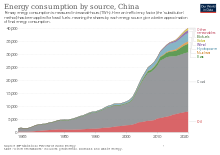

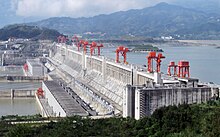
China is both the world's largest energy consumer and the largest industrial country, and ensuring adequate energy supply to sustain economic growth has been a core concern of the Chinese Government since the founding of the People's Republic of China in 1949.[134] Since the country's industrialization in the 1960s, China is currently the world's largest emitter of greenhouse gases, and coal in China is a major cause of global warming.[135] China is also the world's largest renewable energy producer (see this article), and the largest producer of hydroelectricity, solar power and wind power in the world. The energy policy of China is connected to its industrial policy, where the goals of China's industrial production dictate its energy demand managements.[136]
Being a country that depends heavily on foreign petroleum import for both domestic consumption and as raw materials for light industry manufacturing, electrification is a huge component of the Chinese national energy policy.India
India has set renewable energy goals to transition 50% [137] of its total energy consumption into renewable sources in the Paris climate accords. As of 2022 the Central Electricity Authority are well on track of achieving their goals, producing 160 GW electricity from clean sources like solar, wind, hydro power and nuclear power plants, this is 40% of its total capacity. India is ranked third on Ernst and Young's renewable energy country attractive index behind the US and China.
Hydro electric power plants are a major part of India's energy infrastructure since the days of its independence in 1947. Former prime Minister Jawahar Lal Nehru called them the " temples of modern India" and believed them to be key drivers of modernity and industrialism for the nascent republic. Notable examples of hydro power stations include the 2400 MW Tehri hydropower complex, the 1960 MW Koyna hydroelectric project and the 1670 MW Srisailam Dam. Recently, India has given due importance to emerging renewable technologies like solar power plants and wind farms. They house 3 of the world's top 5 solar farms, including world's largest 2255 MW Bhadla Solar Park in and world's second-largest solar park of 2000 MW Pavgada Solar Park and 100 MW Kurnool Ultra mega solar park.
While there has been positive change, air pollution from coal still kills many people[138] and India has to cut down its reliance on traditional coal based power production as it still accounts for around 50% of its energy production. India is also moving towards its goal for electrification of the automotive industry,[139] aiming to have at least 30% EV ownership among private vehicles by 2030.
Vietnam
Vietnam has led the Southeast Asia in solar and wind uptake, achieving about 20 GW in 2022 from almost zero in 2017.[140] Thailand has the highest number of EV registrations, with 218,000 in 2022.[141] The energy transition in Southeast Asia can be summarized as: Challenging, achievable, and interdependent. This implies that while there are obstacles, feasibility largely relies on international support.[141]
Public demand for improved local environmental quality and government's aims to promote a green economy are found to be key drivers in Vietnam.[140]
Governments ambition to attract international support for green growth initiatives and public demand for a clean environment have been found to be drivers of the energy transition in developing countries, such as Vietnam.[142][143] Thanks to a relatively more conducive investment environment, Vietnam is poised to a faster energy transition than some other ASEAN members[144]
Europe
European Union
The European Green Deal is a set of policy initiatives by the European Commission with the overarching aim of making Europe climate neutral in 2050.[145][146] An impact assessed plan will also be presented to increase the EU's greenhouse gas emission reductions target for 2030 to at least 50% and towards 55% compared with 1990 levels. The plan is to review each existing law on its climate merits, and also introduce new legislation on the circular economy, building renovation, biodiversity, farming and innovation.[146] The president of the European Commission, Ursula von der Leyen, stated that the European Green Deal would be Europe's "man on the Moon moment", as the plan would make Europe the first climate-neutral continent.[146]
A survey found that digitally advanced companies put more money into energy-saving strategies. In the European Union, 59% of companies that have made investments in both basic and advanced technologies have also invested in energy efficiency measures, compared to only 50% of US firms in the same category. Overall, there is a significant disparity between businesses' digital profiles and investments in energy efficiency.[147]
Germany
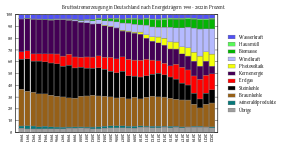
Germany has played an outsized role in the transition away from fossil fuels and nuclear power to renewables. The energy transition in Germany is known as die Energiewende (literally, "the energy turn") indicating a turn away from old fuels and technologies to new one. The key policy document outlining the Energiewende was published by the German government in September 2010, some six months before the Fukushima nuclear accident; legislative support was passed in September 2010.
The policy has been embraced by the German federal government and has resulted in a huge expansion of renewables, particularly wind power. Germany's share of renewables has increased from around 5% in 1999 to 17% in 2010, reaching close to the OECD average of 18% usage of renewables.[148] In 2022 Germany has a share of 46,2 % and surpassed the OECD average.[149] A large driver for this increase in the shares of renewables energy are decreases in cost of capital. Germany boasts some of the lowest cost of capitals for renewable solar and wind onshore energy worldwide. In 2021 the International Renewable Energy Agency reported capital costs of around 1.1% and 2.4% for solar and wind onshore.[150] This constitutes a significant decrease from previous numbers in the early 2000s, where capital costs hovered around 5.1% and 4.5% respectively.[151] This decrease in capital costs was influenced by a variety of economic and political drivers. Following the global financial crisis of 2008–2009, Germany eased the refinancing regulations on banks by giving out cheap loans with low interest rates in order to stimulate the economy again.[152]
During this period, the industry around renewable energies also started to experience learning effects in manufacturing, project organisation as well as financing thanks to rising investment and order volumes. This coupled with various forms of subsidies contributed to a large reduction of the capital cost and the levelized cost of electricity (LCOE) for solar and onshore wind power. As the technologies have matured and become integral parts of the existing sociotechnical systems it is to be expected that in the future, experience effects and general interest rates will be key determinants for the cost-competitiveness of these technologies.[151]
Producers have been guaranteed a fixed feed-in tariff for 20 years, guaranteeing a fixed income. Energy co-operatives have been created, and efforts were made to decentralize control and profits. The large energy companies have a disproportionately small share of the renewables market. Nuclear power stations were closed, and the existing nine stations will close earlier than necessary, in 2022.
The reduction of reliance on nuclear stations has had the consequence of increased reliance on fossil fuels. One factor that has inhibited efficient employment of new renewable energy has been the lack of an accompanying investment in power infrastructure to bring the power to market. It is believed 8300 km of power lines must be built or upgraded.[148]
Different Länder have varying attitudes to the construction of new power lines. Industry has had their rates frozen and so the increased costs of the Energiewende have been passed on to consumers, who have had rising electricity bills. Germans in 2013 had some of the highest electricity costs in Europe.[153] Nonetheless, for the first time in more than ten years, electricity prices for household customers fell at the beginning of 2015.[154]
Switzerland

Due to the high share of hydroelectricity (59.6%) and nuclear power (31.7%) in electricity production, Switzerland's per capita energy-related CO2 emissions are 28% lower than the European Union average and roughly equal to those of France. On 21 May 2017, Swiss voters accepted the new Energy Act establishing the 'energy strategy 2050'. The aims of the energy strategy 2050 are: to reduce energy consumption; to increase energy efficiency; and to promote renewable energies (such as water, solar, wind and geothermal power as well as biomass fuels).[155] The Energy Act of 2006 forbids the construction of new nuclear power plants in Switzerland.[155]
United Kingdom
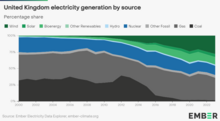
By law production of greenhouse gas emissions by the United Kingdom will be reduced to net zero by 2050.[156] To help in reaching this statutory goal national energy policy is mainly focusing on the country's off-shore wind power and delivering new and advanced nuclear power. The increase in national renewable power – particularly from biomass – together with the 20% of electricity generated by nuclear power in the United Kingdom meant that by 2019 low carbon British electricity had overtaken that generated by fossil fuels.[157]
In order to meet the net zero target energy networks must be strengthened.[158] Electricity is only a part of energy in the United Kingdom, so natural gas used for industrial and residential heat[159] and petroleum used for transport in the United Kingdom must also be replaced[160] by either electricity or another form of low-carbon energy, such as sustainable bioenergy crops[161] or green hydrogen.[162]
Although the need for the energy transition is not disputed by any major political party, in 2020 there is debate about how much of the funding to try and escape the COVID-19 recession should be spent on the transition, and how many jobs could be created, for example in improving energy efficiency in British housing.[163] Some believe that due to post-covid government debt that funding for the transition will be insufficient.[164] Brexit may significantly affect the energy transition, but this is unclear as of 2020[update].[165] The government is urging UK business to sponsor the climate change conference in 2021, possibly including energy companies but only if they have a credible short-term plan for the energy transition.[166]
See also
- Mobility transition – change in transport planning, and transport policy
- Hydrogen economy – Using hydrogen to decarbonize more sectors
- List of countries by renewable electricity production
- List of energy storage power plants
- List of renewable energy topics by country and territory
- Low carbon economy – Climate-friendly economy
References
- ^ Andrew, Robbie. "Figures from the Global Carbon Budget 2021". Retrieved 2022-05-22.
- ^ Tian, Jinfang; Yu, Longguang; Xue, Rui; Zhuang, Shan; Shan, Yuli (2022-02-01). "Global low-carbon energy transition in the post-COVID-19 era". Applied Energy. 307: 118205. Bibcode:2022ApEn..30718205T. doi:10.1016/j.apenergy.2021.118205. ISSN 0306-2619. PMC 8610812. PMID 34840400.
- ^ Davidsson, Simon (2015). "Global Energy Transitions" (PDF).
- ^ Smil, Vaclav. "Energy Transitions" (PDF). Archived from the original (PDF) on 2023-03-09. Retrieved 2022-06-07.
- ^ "Fossil Energy". Center on Global Energy Policy at Columbia University SIPA | CGEP. Retrieved 2024-04-16.
- ^ "Greenhouse Gas Emissions from Energy Data Explorer – Data Tools". IEA. Retrieved 2024-04-16.
- ^ "The Paris Agreement". United Nations Framework Convention on Climate Change. Archived from the original on 2021-03-19. Retrieved 2021-09-18.
- ^ "Plunging cost of wind and solar marks turning point in energy transition: IRENA". Reuters. 2020-06-01. Archived from the original on 2020-08-10. Retrieved 2020-06-02.
- ^ "Life Cycle Assessment of Electricity Generation Options" (PDF). United Nations Economic Commission for Europe. 2021. pp. 49–55. Retrieved 2022-06-01.
- ^ "Are renewable heating options cost-competitive with fossil fuels in the residential sector?". IEA. 2021. Retrieved 2022-06-25.
- ^ Kök, A. Gürhan; Shang, Kevin; Yücel, Safak (2020-01-23). "Investments in Renewable and Conventional Energy: The Role of Operational Flexibility". Manufacturing & Service Operations Management. 22 (5): 925–941. doi:10.1287/msom.2019.0789. ISSN 1523-4614. S2CID 214122213.
- ^ "Abolishing fossil fuel subsidies: a brain teaser rather than a no-brainer".
Reforming fossil fuel subsidies is a complex task for politicians. All in all, our study shows that abolishing fossil fuel subsidies is a no-brainer only for a limited number of subsidies. Abolishing inventoried fossil subsidies does not appear to help the energy transition in all cases. It is important to assess policies from the perspective of adequate pricing of climate damage and other externalities.
- ^ Tripathi, Bhasker. "How fossil fuel subsidies are hurting the energy transition | Context". www.context.news. Retrieved 2024-04-16.
- ^ a b Jaccard, Mark (2020). "Chapter 11 – "Renewables Have Won"". The Citizen's Guide to Climate Success: Overcoming Myths that Hinder Progress. Cambridge University Press. ISBN 978-1-108-47937-0. OCLC 1110157223. Archived from the original on 2021-09-12.
- ^ a b IPCC, 2022: Annex I: Glossary [van Diemen, R., J.B.R. Matthews, V. Möller, J.S. Fuglestvedt, V. Masson-Delmotte, C. Méndez, A. Reisinger, S. Semenov (eds)]. In IPCC, 2022: Climate Change 2022: Mitigation of Climate Change. Contribution of Working Group III to the Sixth Assessment Report of the Intergovernmental Panel on Climate Change [P.R. Shukla, J. Skea, R. Slade, A. Al Khourdajie, R. van Diemen, D. McCollum, M. Pathak, S. Some, P. Vyas, R. Fradera, M. Belkacemi, A. Hasija, G. Lisboa, S. Luz, J. Malley, (eds.)]. Cambridge University Press, Cambridge, UK and New York, NY, USA. doi: 10.1017/9781009157926.020
- ^ Carter, Jimmy. "Address to the Nation on Energy". The American Presidency Project. UC Santa Barbara. Retrieved 2022-06-19.
- ^ Basosi, Duccio (2020-03-20). "Lost in transition. The world's energy past, present and future at the 1981 United Nations Conference on New and Renewable Sources of Energy". Journal of Energy History. 4. Retrieved 2022-06-19.
- ^ "The Paris Agreement". UNFCCC. Retrieved 2021-01-02.
- ^ Rogelj, Joeri; Forster, Piers M.; Kriegler, Elmar; Smith, Christopher J.; Séférian, Roland (July 2019). "Estimating and tracking the remaining carbon budget for stringent climate targets". Nature. 571 (7765): 335–342. Bibcode:2019Natur.571..335R. doi:10.1038/s41586-019-1368-z. hdl:10044/1/78011. ISSN 1476-4687. PMID 31316194.
- ^ Louis Boisgibault, Fahad Al Kabbani (2020): Energy Transition in Metropolises, Rural Areas and Deserts. Wiley - ISTE. (Energy series) ISBN 9781786304995.
- ^ Krumdieck, Susan (2020). Transition Engineering, Building a Sustainable Future. CRC Press. ISBN 978-0-367-34126-8.
- ^ Fressoz, Jean-Baptiste (2024-10-03). More and More and More.
- ^ "Renewable energy explained". eia.gov. U.S. Energy Information Administration. April 2022. Archived from the original on 2023-03-13.
Data source: U.S. Energy Information Administration, Monthly Energy Review, Appendix D.1, and Tables 1.3 an 10.1, April 2022, preliminary data for 2021. / Wood includes wood and wood waste; Renewables includes biofuels, geothermal, solar and wind.
- ^ Smil, Vaclav (2010). Energy Transitions. History, Requirements, Prospects. Praeger. ISBN 978-0-313-38177-5.
- ^ Häfelse, W; Sassin, W (1977). "The global energy system". Annual Review of Energy. 2: 1–30. doi:10.1146/annurev.eg.02.110177.000245.
- ^ Fressoz, Jean-Baptiste (2014). "Pour une histoire désorientée de l'énergie". HAL Open Science. Retrieved 2022-03-12.
- ^ "Figure 1: World Energy Consumption by Source, based on Vaclav Smil".
- ^ Höök, Mikael; Li, Junchen; Johansson, Kersti; Snowden, Simon (2011). "Growth Rates of Global Energy Systems and Future Outlooks". Natural Resources Research. 21 (1): 23–41. doi:10.1007/s11053-011-9162-0. S2CID 154697732.
- ^ Sovacool, Benjamin K. (2016-03-01). "How long will it take? Conceptualizing the temporal dynamics of energy transitions". Energy Research & Social Science. 13: 202–215. Bibcode:2016ERSS...13..202S. doi:10.1016/j.erss.2015.12.020. ISSN 2214-6296.
- ^ Podobnik, B. (1999). "Toward a sustainable energy regime: a long-wave interpretation of global energy shifts". Technological Forecasting and Social Change. 62 (3): 155–172. doi:10.1016/S0040-1625(99)00042-6.
- ^ Rühl, C.; Appleby, P.; Fennema, F.; Naumov, A.; Schaffer, M. (2012). "Economic development and the demand for energy: a historical perspective on the next 20 years". Energy Policy. 50: 109–116. Bibcode:2012EnPol..50..109R. doi:10.1016/j.enpol.2012.07.039.
- ^ Debeir, J.C.; Deléage, J.P.; Hémery, D. (1991). In the Servitude of Power: Energy and Civilisation Through the Ages. London: Zed Books. ISBN 9780862329426.
- ^ Nef, J.U (1977). "Early energy crisis and its consequences". Scientific American. 237 (5): 140–151. Bibcode:1977SciAm.237e.140N. doi:10.1038/scientificamerican1177-140.
- ^ Fouquet, R.; Pearson, P.J.G. (1998). "A thousand years of energy use in the United Kingdom". The Energy Journal. 19 (4): 1–41. doi:10.5547/ISSN0195-6574-EJ-Vol19-No4-1. JSTOR 41322802.
- ^ Unger, R.W. (1984). "Energy sources for the dutch golden age: peat, wind, and coal". Research in Economic History. 9: 221–256.
- ^ Bardi, U. (2007). "Energy prices and resource depletion: lessons from the case of whaling in the nineteenth century" (PDF). Energy Sources, Part B: Economics, Planning, and Policy. 2 (3): 297–304. Bibcode:2007EneSB...2..297B. doi:10.1080/15567240600629435. hdl:2158/776587. S2CID 37970344. Archived from the original (PDF) on 2021-06-24. Retrieved 2020-03-23.
- ^ "The Great Carbon Arbitrage: Going short on coal and long on renewables | Stanford Institute for Economic Policy Research (SIEPR)". siepr.stanford.edu. Retrieved 2023-03-29.
- ^ Chrobak, Ula; Chodosh, Sara (2021-01-28). "Solar power got cheap. So why aren't we using it more?". Popular Science. Archived from the original on 2021-01-29.
- ^ "Lazard LCOE Levelized Cost Of Energy+" (PDF). Lazard. June 2024. p. 16. Archived (PDF) from the original on 2024-08-28.
- ^ Ritchie, Hannah; Roser, Max (2021). "What are the safest and cleanest sources of energy?". Our World in Data. Archived from the original on 2024-01-15. Data sources: Markandya & Wilkinson (2007); UNSCEAR (2008; 2018); Sovacool et al. (2016); IPCC AR5 (2014); Pehl et al. (2017); Ember Energy (2021).
- ^ M. Pathak, R. Slade, P.R. Shukla, J. Skea, R. Pichs-Madruga, D. Ürge-Vorsatz,2022: Technical Summary. In: Climate Change 2022: Mitigation of Climate Change. Contribution of Working Group III to the Sixth Assessment Report of the Intergovernmental Panel on Climate Change [P.R. Shukla, J. Skea, R. Slade, A. Al Khourdajie, R. van Diemen, D. McCollum, M. Pathak, S. Some, P. Vyas, R. Fradera, M. Belkacemi, A. Hasija, G. Lisboa, S. Luz, J. Malley, (eds.)]. Cambridge University Press, Cambridge, UK and New York, NY, USA. doi: 10.1017/9781009157926.002.
- ^ UN Energy (2021) Theme Report on Energy Transition towards the Achievement of SDG 7 and Net-Zero Emissions
- ^ Olivier, J.G.J.; Peters, J.A.H.W. (2020). "Trends in global CO2 and total greenhouse gas emissions (2020)" (PDF). The Hague: PBL Netherlands Environmental Assessment Agency.
- ^ "Statistical Review of World Energy 2021" (PDF). BP. Retrieved 2022-05-29.
- ^ Suzuki, Masahiro; Jewell, Jessica; Cherp, Aleh (2023-11-09). "Have climate policies accelerated energy transitions? Historical evolution of electricity mix in the G7 and the EU compared to net-zero targets". Energy Research & Social Science. 106: 103281. doi:10.1016/j.erss.2023.103281. hdl:20.500.14018/14250.
- ^ IASS/Green ID (2019). "Future skills and job creation through renewable energy in Vietnam. Assessing the co-benefits of decarbonising the power sector" (PDF).
- ^ "Realizing the Green Jobs Promise". RMI. Retrieved 2024-04-18.
- ^ "Renewables set to energize Africa's growth". UNEP. 2018-01-16. Retrieved 2024-04-18.
- ^ "Renewable energy offers Africa's best opportunity to achieve the Sustainable Development Goals, experts say".
- ^ Louie, Edward P.; Pearce, Joshua M. (2016-06-01). "Retraining investment for U.S. transition from coal to solar photovoltaic employment". Energy Economics. 57: 295–302. Bibcode:2016EneEc..57..295L. doi:10.1016/j.eneco.2016.05.016. ISSN 0140-9883.
- ^ a b Meyer, Theresa K.; Hunsberger, Carol; Pearce, Joshua M. (2023-09-30). "Retraining investment for Alberta's oil and gas workers for green jobs in the solar industry". Carbon Neutrality. 2 (1): 28. Bibcode:2023CarNe...2...28M. doi:10.1007/s43979-023-00067-3. ISSN 2731-3948.
- ^ "How to ensure Alberta's oil and gas workers have jobs during the energy transition - Alberta News". 2023-11-01. Retrieved 2023-12-20.
- ^ IASS/TERI. "Secure and reliable electricity access with renewable energy mini-grids in rural India. Assessing the co-benefits of decarbonising the power sector" (PDF).
- ^ "Regional Cohesion in Europe 2021-2022". EIB.org. Retrieved 2022-08-09.
- ^ "Press corner". European Commission - European Commission. Retrieved 2022-08-16.
- ^ Taplin, Nathaniel. "For Taiwan, as for Ukraine, Energy Security Is Existential". WSJ. Retrieved 2024-04-18.
- ^ "EURACTIV Press Release Site". EURACTIV PR. Retrieved 2022-05-22.
- ^ "Europe is importing a solar boom. Good news for (nearly) everyone". The Economist. ISSN 0013-0613. Retrieved 2024-04-18.
- ^ Toll, Micah (2022-05-12). "This quiet electric motorcycle is helping Ukrainian snipers fight back against the Russians". Electrek. Retrieved 2024-04-18.
- ^ Farley, Robert (2023-11-11). "Trump's False Claim That U.S. Military Moving to Electric Tanks". FactCheck.org. Retrieved 2024-04-18.
- ^ https://www.cfe-dmha.org/LinkClick.aspx?fileticket=sJ7hhDPJFl8%3D&portalid=0
- ^ Institute, Global Taiwan (2024-02-07). "Geopolitics and Energy Security in Taiwan: A Refined Analysis". Global Taiwan Institute. Retrieved 2024-04-18.
- ^ "Ukrenergo: Russia targeted solar power plant in Ukraine's rear for the first time". Yahoo News. 2024-04-04. Retrieved 2024-04-18.
- ^ "Taiwan war game exposes vulnerability of energy grid to a China attack". www.ft.com. Retrieved 2024-04-18.
- ^ "Solar: the military's secret weapon" (PDF).
- ^ "Ukraine and Kyrgyzstan. How solar power can help communities in crisis - CANEECCA: Восточная Европа, Кавказ и Центральная Азия". caneecca.org (in Russian). 2022-10-23. Retrieved 2024-04-18.
- ^ "Solar-Powered Defense: How Renewable Energy is Shaping Modern Military Operation". Foresight Learning. 2023-11-08. Retrieved 2024-04-18.
- ^ Roza, David (2023-10-31). "Why the Military May Need Microgrids to Win A Near-Peer Fight". Air & Space Forces Magazine. Retrieved 2024-04-18.
- ^ "Ukraine says Russia's attacks are threatening energy security". Voice of America. 2024-03-29. Retrieved 2024-04-18.
- ^ "Taiwan's Election Has Big Ramifications for Energy Security". thediplomat.com. Retrieved 2024-04-18.
- ^ Przybylak, Joanna (2023-11-27). "Nuclear power plants in war zones: Lessons learned from the war in Ukraine". Security and Defence Quarterly. doi:10.35467/sdq/174810. ISSN 2300-8741.
- ^ "Critical Minerals – Topics". IEA. Retrieved 2024-06-10.
- ^ "Global Critical Minerals Outlook 2024 – Analysis". IEA. 2024-05-17. Retrieved 2024-06-13.
- ^ "Yesterday mineral supplier, tomorrow battery producer - The Nordic Africa Institute". nai.uu.se. Retrieved 2024-06-10.
- ^ "AMV – Africa Mining Vision | African Union". au.int. Retrieved 2024-06-10.
- ^ "Yesterday mineral supplier, tomorrow battery producer - The Nordic Africa Institute". nai.uu.se. Retrieved 2024-06-10.
- ^ a b c d e f IPCC, 2022: Summary for Policymakers. In: Climate Change 2022: Mitigation of Climate Change. Contribution of Working Group III to the Sixth Assessment Report of the Intergovernmental Panel on Climate Change [P.R. Shukla, J. Skea, R. Slade, A. Al Khourdajie, R. van Diemen, D. McCollum, M. Pathak, S. Some, P. Vyas, R. Fradera, M. Belkacemi, A. Hasija, G. Lisboa, S. Luz, J. Malley, (eds.)]. Cambridge University Press, Cambridge, UK and New York, NY, USA. doi: 10.1017/9781009157926.001
- ^ "Levelized Cost of Energy+". www.lazard.com. Retrieved 2024-08-06.
- ^ IRENA (2022), Renewable Energy Statistics 2022, The International Renewable Energy Agency, Abu Dhabi
- ^ United Nations Environment Programme (2019). Emissions Gap Report 2019. UNEP, Nairobi.
- ^ IPCC (2014). Edenhofer, O.; Pichs-Madruga, R.; Sokona, Y.; Farahani, E.; et al. (eds.). Climate Change 2014: Mitigation of Climate Change: Working Group III contribution to the Fifth Assessment Report of the Intergovernmental Panel on Climate Change. Cambridge University Press. ISBN 978-1-107-05821-7. OCLC 892580682. Archived from the original on 2017-01-26.
- ^ "Energy Transition Investment Hit $500 Billion in 2020 – For First Time". BloombergNEF. (Bloomberg New Energy Finance). 2021-01-19. Archived from the original on 2021-01-19.
- ^ Catsaros, Oktavia (2023-01-26). "Global Low-Carbon Energy Technology Investment Surges Past $1 Trillion for the First Time". Figure 1: Bloomberg NEF (New Energy Finance). Archived from the original on 2023-05-22.
Defying supply chain disruptions and macroeconomic headwinds, 2022 energy transition investment jumped 31% to draw level with fossil fuels
{cite news}: CS1 maint: location (link) - ^ "Global Clean Energy Investment Jumps 17%, Hits $1.8 Trillion in 2023, According to BloombergNEF Report". BNEF.com. Bloomberg NEF. 2024-01-30. Archived from the original on 2024-06-28.
Start years differ by sector but all sectors are present from 2020 onwards.
- ^ "Energy Transition Investment Now On Par with Fossil Fuel". Bloomberg NEF (New Energy Finance). 2023-02-10. Archived from the original on 2023-03-27.
- ^ "Share of cumulative power capacity by technology, 2010-2027". IEA.org. International Energy Agency (IEA). 2022-12-05. Archived from the original on 2023-02-04. Source states "Fossil fuel capacity from IEA (2022), World Energy Outlook 2022. IEA. Licence: CC BY 4.0."
- ^ Source for data beginning in 2017: "Renewable Energy Market Update Outlook for 2023 and 2024" (PDF). IEA.org. International Energy Agency (IEA). June 2023. p. 19. Archived (PDF) from the original on 2023-07-11.
IEA. CC BY 4.0.
● Source for data through 2016: "Renewable Energy Market Update / Outlook for 2021 and 2022" (PDF). IEA.org. International Energy Agency. May 2021. p. 8. Archived (PDF) from the original on 2023-03-25.IEA. Licence: CC BY 4.0
- ^ Bond, Kingsmill; Butler-Sloss, Sam; Lovins, Amory; Speelman, Laurens; Topping, Nigel (2023-06-13). "Report / 2023 / X-Change: Electricity / On track for disruption". Rocky Mountain Institute. Archived from the original on 2023-07-13.
- ^ a b "Race to Net Zero: The Pressures of the Battery Boom in Five Charts". 2022-07-21. Archived from the original on 2023-09-07.
- ^ a b "Electricity production". IEA. Retrieved 2022-06-20.
- ^ "Solar Energy Potential". Energy.gov. Archived from the original on 2020-05-23. Retrieved 2020-04-22.
- ^ "Electricity Grids and Secure Energy Transitions – Analysis". IEA. 2023-10-17. Retrieved 2024-04-15.
- ^ IEA (2023), Electricity Grids and Secure Energy Transitions, IEA, Paris https://www.iea.org/reports/electricity-grids-and-secure-energy-transitions, Licence: CC BY 4.0
- ^ Bogdanov, Dmitrii; Gulagi, Ashish; Fasihi, Mahdi; Breyer, Christian (2021-02-01). "Full energy sector transition toward 100% renewable energy supply: Integrating power, heat, transport and industry sectors including desalination". Applied Energy. 283: 116273. Bibcode:2021ApEn..28316273B. doi:10.1016/j.apenergy.2020.116273. ISSN 0306-2619.
- ^ Teske, Sven, ed. (2019). Achieving the Paris Climate Agreement Goals. doi:10.1007/978-3-030-05843-2. ISBN 978-3-030-05842-5. S2CID 198078901.
- ^ "Cheap, safe 100% renewable energy possible before 2050, says Finnish uni study". Yle Uutiset. 2019-04-12. Retrieved 2021-06-18.
- ^ Gulagi, Ashish; Alcanzare, Myron; Bogdanov, Dmitrii; Esparcia, Eugene; Ocon, Joey; Breyer, Christian (2021-07-01). "Transition pathway towards 100% renewable energy across the sectors of power, heat, transport, and desalination for the Philippines". Renewable and Sustainable Energy Reviews. 144: 110934. doi:10.1016/j.rser.2021.110934. ISSN 1364-0321.
- ^ Hansen, Kenneth; et al. (2019). "Status and perspectives on 100% renewable energy systems". Energy. 175: 471–480. Bibcode:2019Ene...175..471H. doi:10.1016/j.energy.2019.03.092.
The great majority of all publications highlights the technical feasibility and economic viability of 100% RE systems.
- ^ Koumoundouros, Tessa (2019-12-27). "Stanford Researchers Have an Exciting Plan to Tackle The Climate Emergency Worldwide". ScienceAlert. Retrieved 2020-01-05.
- ^ Wiseman, John; et al. (April 2013). "Post Carbon Pathways" (PDF). University of Melbourne.
- ^ "Operational & Long-Term Shutdown Reactors". IAEA. 2013-04-13. Retrieved 2013-04-14.
- ^ Murtaugh, Dan; Krystal, Chia (2021-11-02). "China's Climate Goals Hinge on a $440 Billion Nuclear Buildout". Bloomberg. Retrieved 2022-07-31.
- ^ Bogdanov, Dmitrii; Farfan, Javier; Sadovskaia, Kristina; Aghahosseini, Arman; et al. (2019). "Radical transformation pathway towards sustainable electricity via evolutionary steps". Nature Communications. 10 (1): 1077. Bibcode:2019NatCo..10.1077B. doi:10.1038/s41467-019-08855-1. PMC 6403340. PMID 30842423.
- ^ "World Energy Outlook 2020 – Analysis". IEA. 2020-10-13. Retrieved 2024-08-06.
- ^ Abergel, Thibaut (June 2020). "Heat Pumps". IEA. Archived from the original on 2021-03-03. Retrieved 2021-04-12.
- ^ Mueller, Mike (2017-08-01). "5 Things You Should Know about Geothermal Heat Pumps". Office of Energy Efficiency & Renewable Energy. US Department of Energy. Archived from the original on 2021-04-15. Retrieved 2021-04-17.
- ^ "Dream or Reality? Electrification of the Chemical Process Industries". www.aiche-cep.com. Retrieved 2022-01-16.
- ^ Gillespie, Todd (2022-03-16). "Energy Costs Set to Reach Record 13% of Global GDP This Year". Bloomberg.com. Bloomberg. Retrieved 2022-06-20.
- ^ Scholten, D., Criekemans, D., & de Graaf, T. V. (2020). An Energy Transition Amidst Great Power Rivalry. Journal of International Affairs, 73(1), 195–203.
- ^ Chiu, Allyson; Guskin, Emily; Clement, Scott (2023-10-03). "Americans don't hate living near solar and wind farms as much as you might think". The Washington Post. Archived from the original on 2023-10-03.
- ^ Nzaou-Kongo, Aubin (2020). "Energy Transition Governance Research Materials" (PDF). The Energy Transition Governance Research Materials. doi:10.2139/ssrn.3556410. S2CID 216446248. SSRN 3556410.
- ^ Frumhoff, Peter C.; Heede, Richard; Oreskes, Naomi (2015-07-23). "The climate responsibilities of industrial carbon producers". Climatic Change. 132 (2): 157–171. Bibcode:2015ClCh..132..157F. doi:10.1007/s10584-015-1472-5. ISSN 0165-0009.
- ^ Mercure, J.-F.; Pollitt, H.; Viñuales, J. E.; Edwards, N. R.; Holden, P. B.; Chewpreecha, U.; Salas, P.; Sognnaes, I.; Lam, A.; Knobloch, F. (2018-06-04). "Macroeconomic impact of stranded fossil fuel assets" (PDF). Nature Climate Change. 8 (7): 588–593. Bibcode:2018NatCC...8..588M. doi:10.1038/s41558-018-0182-1. hdl:10871/37807. ISSN 1758-678X. S2CID 89799744. Archived (PDF) from the original on 2020-07-28. Retrieved 2020-08-19.
- ^ Howard, Emma (2015). "A Guide to Fossil Fuel Divestment" (PDF). The Guardian. Archived (PDF) from the original on 2020-10-22. Retrieved 2020-03-29.
- ^ "Divestment Commitments". Fossil Free: Divestment. Archived from the original on 2017-11-19. Retrieved 2020-03-29.
- ^ Geopolitics of the energy transition: Energy security. Abu Dhabi. 2024-04-17. pp. 10–12. ISBN 978-92-9260-599-5. Retrieved 2024-04-17.
{cite book}:|website=ignored (help)CS1 maint: date and year (link) CS1 maint: location missing publisher (link) - ^ Hoppe, Thomas; Graf, Antonia; Warbroek, Beau; Lammers, Imke; Lepping, Isabella (2015-02-11). "Local Governments Supporting Local Energy Initiatives: Lessons from the Best Practices of Saerbeck (Germany) and Lochem (The Netherlands)". Sustainability. 7 (2): 1900–1931. doi:10.3390/su7021900. ISSN 2071-1050.
- ^ Neves, Ana Rita; Leal, Vítor (December 2010). "Energy sustainability indicators for local energy planning: Review of current practices and derivation of a new framework". Renewable and Sustainable Energy Reviews. 14 (9): 2723–2735. Bibcode:2010RSERv..14.2723N. doi:10.1016/j.rser.2010.07.067. ISSN 1364-0321.
- ^ SOVACOOL, Benjamin (2011). "Conceptualizing and measuring energy security: A synthesized approach". ink.library.smu.edu.sg. Archived from the original on 2020-03-21. Retrieved 2020-03-29.
- ^ Strangleman, Tim (June 2001). "Networks, Place and Identities in Post-industrial Mining Communities". International Journal of Urban and Regional Research. 25 (2): 253–267. doi:10.1111/1468-2427.00310. ISSN 0309-1317.
- ^ a b Bouzarovski, Stefan; Tirado Herrero, Sergio; Petrova, Saska; Frankowski, Jan; Matoušek, Roman; Maltby, Tomas (2017-01-02). "Multiple transformations: theorizing energy vulnerability as a socio-spatial phenomenon". Geografiska Annaler: Series B, Human Geography. 99 (1): 20–41. doi:10.1080/04353684.2016.1276733. ISSN 0435-3684.
- ^ "Training Available for Dislocated Coal Miners and Dependents « UMWA Career Centers, Inc". umwacc.com. 2015-11-04. Archived from the original on 2020-03-29. Retrieved 2020-03-29.
- ^ a b Do, Thang Nam; Burke, Paul (2023). "Phasing out coal power in a developing country context: Insights from Vietnam". Energy Policy. 176 (May 2023 113512): 113512. Bibcode:2023EnPol.17613512D. doi:10.1016/j.enpol.2023.113512. hdl:1885/286612. S2CID 257356936.
- ^ Marín, Anabel; Goya, Daniel (2021-12-01). "Mining—The dark side of the energy transition". Environmental Innovation and Societal Transitions. Celebrating a decade of EIST: What's next for transition studies?. 41: 86–88. Bibcode:2021EIST...41...86M. doi:10.1016/j.eist.2021.09.011. ISSN 2210-4224. S2CID 239975201.
The energy transition will significantly increase demand for minerals....The increasing number of social and environmental conflicts associated with mining in emerging economies is a manifestation of this tension and raises questions about just energy transitions
- ^ "Korean firms asked to consult with indigenous peoples prior to searching for renewable energy resources". Korea Times. 2022-08-11. Retrieved 2023-01-03.
- ^ Pai, Sandeep; Carr-Wilson, Savannah (2018). Total Transition: The Human Side of the Renewable Energy Revolution. Rocky Mountain Books. ISBN 978-1-77160-248-8. Archived from the original on 2021-05-10. Retrieved 2020-10-03.
- ^ Stevis-Gridneff, Matina (2022-10-07). "Europe's Energy Crisis Exposes Old Fault Lines and New Power Dynamics". The New York Times.
- ^ Alova, G. (2020). "A global analysis of the progress and failure of electric utilities to adapt their portfolios of power-generation assets to the energy transition". Nature Energy. 5 (11): 920–927. Bibcode:2020NatEn...5..920A. doi:10.1038/s41560-020-00686-5. ISSN 2058-7546. S2CID 225179903. Archived from the original on 2021-03-21. Retrieved 2021-04-16.
- ^ BP: Statistical Review of World Energy Archived 17 October 2020 at the Wayback Machine, Workbook (xlsx), London, 2016
- ^ World Energy Assessment Archived 12 November 2020 at the Wayback Machine (WEA). UNDP, United Nations Department of Economic and Social Affairs, World Energy Council, New York
- ^ "The Economics of Nuclear Power". World Nuclear Association. World Nuclear Association. Retrieved 2024-12-06.
- ^ "Lazard Levelized Cost of Energy June 2024" (PDF). Lazard. Retrieved 2024-12-06.
- ^ "Statistical Review of World Energy (June 2018)" (PDF). Retrieved 2019-09-27.
- ^ Andrews-Speed, Philip (November 2014). "China's Energy Policymaking Processes and Their Consequences". The National Bureau of Asian Research Energy Security Report. Retrieved 2014-12-05.
- ^ McGrath, Matt (2019-11-20). "China coal surge threatens Paris climate targets". Retrieved 2019-12-09.
- ^ Rosen, Daniel; Houser, Trevor (May 2007). "China Energy A Guide for the Perplexed" (PDF). piie.com. Retrieved 2020-04-25.
- ^ "Renewable Energy in India - Indian Power Industry Investment". www.investindia.gov.in. Retrieved 2022-12-06.
- ^ Fuller, Gary (2024-04-19). "Clean-up of Indian coal-fired power plants 'could have saved 720,000 lives'". The Guardian. ISSN 0261-3077. Retrieved 2024-04-19.
- ^ "The Electric Vehicle (EV) sector in India to boost both the ec..." www.investindia.gov.in. Retrieved 2022-12-06.
- ^ a b Do, Thang Nam; Burke, Paul J.; Nguyen, Hoang Nam; Overland, Indra; Suryadi, Beni; Swandaru, Akbar; Yurnaidi, Zulfikar (2021-12-01). "Vietnam's solar and wind power success: Policy implications for the other ASEAN countries". Energy for Sustainable Development. 65: 1–11. Bibcode:2021ESusD..65....1D. doi:10.1016/j.esd.2021.09.002. hdl:1885/248804. ISSN 0973-0826.
- ^ a b Do, Thang Nam (May 2024). "Insider perspectives on Southeast Asiaʼs clean energy transition". Asia & the Pacific Policy Studies. 11 (2). doi:10.1002/app5.390. ISSN 2050-2680.
- ^ Do, Thang Nam (2023). "Phasing out coal power in a developing country context: Insights from Vietnam". Energy Policy. 176 (May 2023 113512): 113512. Bibcode:2023EnPol.17613512D. doi:10.1016/j.enpol.2023.113512. hdl:1885/286612. S2CID 257356936.
- ^ Do, Thang Nam; Burke, Paul, J.; Baldwin, Ken; Nguyen, T.C. (2020). "Underlying drivers and barriers for solar photovoltaics diffusion: The case of Vietnam". Energy Policy. 144 (September 2020): 111561. Bibcode:2020EnPol.14411561D. doi:10.1016/j.enpol.2020.111561. hdl:1885/206307. S2CID 225245522.
{cite journal}: CS1 maint: multiple names: authors list (link) - ^ Do, Thang Nam; Burke, Paul J. (2024-06-01). "Phasing out coal power in two major Southeast Asian thermal coal economies: Indonesia and Vietnam". Energy for Sustainable Development. 80: 101451. Bibcode:2024ESusD..8001451D. doi:10.1016/j.esd.2024.101451. hdl:1885/317223. ISSN 0973-0826.
- ^ Tamma, Paola; Schaart, Eline; Gurzu, Anca (2019-12-11). "Europe's Green Deal plan unveiled". POLITICO. Archived from the original on 2020-11-28. Retrieved 2019-12-29.
- ^ a b c Simon, Frédéric (2019-12-11). "EU Commission unveils 'European Green Deal': The key points". www.euractiv.com. Archived from the original on 2020-12-15. Retrieved 2019-12-29.
- ^ Bank, European Investment (2022-05-05). Digitalisation in Europe 2021-2022: Evidence from the EIB Investment Survey. European Investment Bank. ISBN 978-92-861-5233-7.
- ^ a b "Germany's energy transformation Energiewende". The Economist. 2012-07-28. Archived from the original on 2018-01-15. Retrieved 2013-03-06.
- ^ "Wo steht Deutschland bei der Energiewende". Die Bundesregierung informiert | Startseite (in German). 2023-07-12. Retrieved 2023-09-14.
- ^ "The cost of financing for renewable power". www.irena.org. 2023-05-03. Retrieved 2023-11-03.
- ^ a b Egli, Florian; Steffen, Bjarne; Schmidt, Tobias S. (December 2018). "A dynamic analysis of financing conditions for renewable energy technologies". Nature Energy. 3 (12): 1084–1092. Bibcode:2018NatEn...3.1084E. doi:10.1038/s41560-018-0277-y. hdl:20.500.11850/309636. ISSN 2058-7546.
- ^ Furman, Jason. "A Reconsideration of Fiscal Policy in the Era of Low Interest Rates" (PDF).
- ^ "Germany's energy reform: Troubled turn". The Economist. 2013-02-09. Archived from the original on 2013-03-04. Retrieved 2013-03-06.
- ^ The Energy of the Future: Fourth "Energy Transition" Monitoring Report — Summary (PDF). Berlin, Germany: Federal Ministry for Economic Affairs and Energy (BMWi). November 2015. Archived from the original (PDF) on 2016-09-20. Retrieved 2016-06-09.
- ^ a b Energy strategy 2050 Archived 19 May 2017 at the Wayback Machine, Swiss Federal Office of Energy, Federal Department of Environment, Transport, Energy and Communications (page visited on 21 May 2017).
- ^ "The Ten Point Plan for a Green Industrial Revolution (HTML version)". GOV.UK. Retrieved 2022-06-01.
- ^ Group, Drax. "Drax Electric Insights". Drax Electric Insights. Archived from the original on 2020-10-10. Retrieved 2020-09-10.
{cite web}:|last=has generic name (help) - ^ "Reducing UK emissions: 2020 Progress Report to Parliament". Committee on Climate Change. Archived from the original on 2020-09-20. Retrieved 2020-09-10.
- ^ "Decarbonisation of Heat". Energy Systems Catapult. Archived from the original on 2020-09-18. Retrieved 2020-09-10.
- ^ "Office for Low Emission Vehicles". GOV.UK. 2019-06-04. Archived from the original on 2020-09-11. Retrieved 2020-09-10.
- ^ "Land use: Policies for a Net Zero UK". Committee on Climate Change. Archived from the original on 2020-09-22. Retrieved 2020-09-10.
- ^ Frangoul, Anmar (2020-02-18). "UK government announces millions in funding for 'low carbon' hydrogen production". CNBC. Archived from the original on 2020-10-29. Retrieved 2020-09-10.
- ^ Boydell, Ranald (2020-06-22). "Why zero-carbon homes must lead the green recovery from COVID-19". The Conversation. Archived from the original on 2020-09-09. Retrieved 2020-09-10.
- ^ Penman, Hamish (2020-09-02). "Gulf between government ambition and ability to deliver green energy transition". The Courier. Archived from the original on 2020-09-17. Retrieved 2020-09-10.
- ^ Grubb, Professor Michael (2020-09-08). "Why a deal on energy could break the Brexit logjam". www.euractiv.com. Archived from the original on 2020-09-12. Retrieved 2020-09-10.
- ^ "Big oil need not apply: UK raises the bar for UN climate summit sponsorship". Climate Home News. 2020-08-18. Archived from the original on 2020-09-23. Retrieved 2020-09-10.
